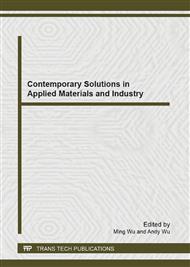[1]
X. Li, Inhibitory role of TACE/ADAM17 cytotail in protein ectodomain shedding, WJBC, vol. 2, no. 11, p.246, (2011).
DOI: 10.4331/wjbc.v2.i11.246
Google Scholar
[2]
X. Li, L. Pérez, Z. Pan, and H. Fan, The transmembrane domain of TACE regulates protein ectodomain shedding, Cell Res, vol. 17, no. 12, p.985–998, Dec. (2007).
DOI: 10.1038/cr.2007.98
Google Scholar
[3]
P. Saftig and K. Reiss, The A Disintegrin And Metalloproteases' ADAM10 and ADAM17: novel drug targets with therapeutic potential, Eur. J. Cell Biol., vol. 90, no. 6, p.527–535, Jun. (2011).
DOI: 10.1016/j.ejcb.2010.11.005
Google Scholar
[4]
K. P. Fong, C. Barry, A. N. Tran, E. A. Traxler, K. M. Wannemacher, H. -Y. Tang, K. D. Speicher, I. A. Blair, D. W. Speicher, T. Grosser, and L. F. Brass, Deciphering the human platelet sheddome., Blood, vol. 117, no. 1, pp. e15–26, Jan. (2011).
DOI: 10.1182/blood-2010-05-283838
Google Scholar
[5]
S. F. Lichtenthaler, Sheddase Gets Guidance, Science, vol. 335, no. 6065, p.179–180, Jan. (2012).
DOI: 10.1126/science.1216815
Google Scholar
[6]
J. Scheller, A. Chalaris, C. Garbers, and S. Rose-John, ADAM17: a molecular switch to control inflammation and tissue regeneration., Trends Immunol., vol. 32, no. 8, p.380–387, Aug. (2011).
DOI: 10.1016/j.it.2011.05.005
Google Scholar
[7]
A. Baumgart, S. Seidl, P. Vlachou, L. Michel, N. Mitova, N. Schatz, K. Specht, I. Koch, T. Schuster, R. Grundler, M. Kremer, F. Fend, J. T. Siveke, C. Peschel, J. Duyster, and T. Dechow, ADAM17 Regulates Epidermal Growth Factor Receptor Expression through the Activation of Notch1 in Non-Small Cell Lung Cancer, Cancer Research, vol. 70, no. 13, p.5368–5378, Jun. (2010).
DOI: 10.1158/0008-5472.can-09-3763
Google Scholar
[8]
M. Gooz, ADAM-17: the enzyme that does it all, Critical Reviews in Biochemistry and Molecular Biology, vol. 45, no. 2, p.146–169, Apr. (2010).
DOI: 10.3109/10409231003628015
Google Scholar
[9]
J. Arribas and C. Esselens, ADAM17 as a therapeutic target in multiple diseases., Curr. Pharm. Des., vol. 15, no. 20, p.2319–2335, (2009).
DOI: 10.2174/138161209788682398
Google Scholar
[10]
P. E. Gonzales, A. Solomon, A. B. Miller, M. A. Leesnitzer, I. Sagi, and M. E. Milla, Inhibition of the tumor necrosis factor-alpha-converting enzyme by its pro domain., Journal of Biological Chemistry, vol. 279, no. 30, p.31638–31645, Jul. (2004).
DOI: 10.1074/jbc.m401311200
Google Scholar
[11]
S. DasGupta, P. R. Murumkar, R. Giridhar, and M. R. Yadav, Current perspective of TACE inhibitors: A review, Bioorganic & Medicinal Chemistry, vol. 17, no. 2, p.444–459, Jan. (2009).
DOI: 10.1016/j.bmc.2008.11.067
Google Scholar
[12]
I. H. Tarner, U. Müller-Ladner, and S. Gay, Emerging targets of biologic therapies for rheumatoid arthritis, Nat Clin Pract Rheumatol, vol. 3, no. 6, p.336–345, Jun. (2007).
DOI: 10.1038/ncprheum0506
Google Scholar
[13]
K. Maskos, C. Fernandez-Catalan, R. Huber, G. P. Bourenkov, H. Bartunik, G. A. Ellestad, P. Reddy, M. F. Wolfson, C. T. Rauch, and B. J. Castner, Crystal structure of the catalytic domain of human tumor necrosis factor-α-converting enzyme, Proc. Natl. Acad. Sci. U.S.A., vol. 95, no. 7, p.3408, (1998).
DOI: 10.1073/pnas.95.7.3408
Google Scholar
[14]
B. Raveh, N. London, L. Zimmerman, and O. Schueler-Furman, Rosetta FlexPepDock ab-initio: simultaneous folding, docking and refinement of peptides onto their receptors., PLoS ONE, vol. 6, no. 4, p. e18934, (2011).
DOI: 10.1371/journal.pone.0018934
Google Scholar
[15]
J. C. Phillips, R. Braun, W. Wang, J. Gumbart, E. Tajkhorshid, E. Villa, C. Chipot, R. D. Skeel, L. Kalé, and K. Schulten, Scalable molecular dynamics with NAMD., J. Comput. Chem., vol. 26, no. 16, p.1781–1802, Dec. (2005).
DOI: 10.1002/jcc.20289
Google Scholar
[16]
W. Humphrey, A. Dalke, and K. Schulten, VMD: visual molecular dynamics., J Mol Graph, vol. 14, no. 1, p.33–8– 27–8, Feb. (1996).
DOI: 10.1016/0263-7855(96)00018-5
Google Scholar


